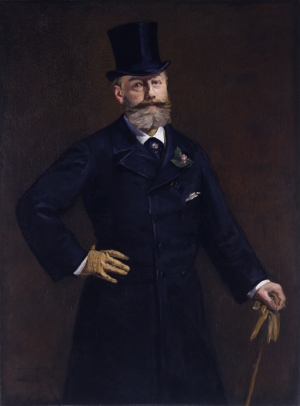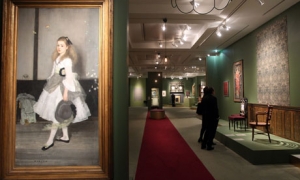|
Displaying items by tag: impressionism

Manet: Portraying Life opens on January 26, 2013 at the Royal Academy of Arts in London. The first exhibition to focus solely on French Impressionist Edouard Manet’s (1832-1883) portraits, Portraying Life has already sold more advanced tickets than the museum’s blockbuster Vincent van Gogh (1853-1890) exhibition in 2010. Certain timed ticket entrances have sold out entirely.
The show, which took six years to organize, spans Manet’s entire career and features works from Europe, Asia, and the United States. Portraying Life is comprised of 50 paintings and a few pastels and includes portraits of Manet’s favorite sitters such as his wife, Suzanne Leenhoff (1829-1906), and luminaries from the time period including Antonin Proust (1832-1905) and Émile Zola (1840-1902). Manet, who often painted family, friends, and important political as well as artistic figures, invigorated scenes of everyday life with his modern and progressive approach to portraiture.
While Portraying Manet is expected to be a hit show, there has been a hiccup in plans. London’s snowy weather has left one painting stranded in Brazil’s São Paulo airport; the portrait of Mademoiselle Marie Lefébure is awaiting flight clearance before it can be exhibited at the Royal Academy. Sadly, the painting was not present at the press preview on January 22, 2013, which included VIP guests, patrons, and sponsors. Officials hope the work will arrive in time for exhibition’s public opening on Saturday.
Manet: Portraying Life will be on view through April 14, 2013.
When was the last time an expert from a top auction house dispensed with longtime allegiances and joined forces with someone from the enemy camp? In the fiercely competitive world of Sotheby’s and Christie’s, such an occurrence is rarer than a prized Vermeer.
But for months now there have been rumors that a new powerhouse partnership was in the works, one that would replace Giraud, Pissarro, Ségalot, the superprivate superdealer that pulled off so many big transactions and whose business began winding down soon after Franck Giraud, one of its partners, announced that he was leaving to “explore options inside the art world and out.”
The players making up this new venture, however, had been something of a guessing game.
Wassily Kandinsky, the Russian-born painter famous for his vibrant colors and early abstract techniques, is set to break records at Christie's this November. His 1909 painting "Study for Impression 8" was recently announced as the "first star lot" of the auction house's upcoming Impressionist and Modern Art sale, boasting an estimated price tag of $20-$30 million, according to Reuters.
"Study for Impression 8" is being sold by the Volkart Foundation, the charitable trust of 160-year-old Swiss commodities trading firm Volkart Brothers. After having spent time on loan to numerous art museums like London's Tate Modern and Musée des Beaux-Arts in Montréal, it's now poised to become Kandinsky's most expensive masterpiece, beating out his "Study for Improvisation 3," which sold for a whopping $16.9 million at Christie's in 2006, and the reigning auction record holder "Fugue," which went for $20.9 million at Sotheby's in 1990.
Christie’s New York has announced that two classic works on paper by Norman Rockwell will lead its American Art auction in September.
One of the Rockwell drawings, Study for ‘The Runaway,’ illustrates a young boy and a policeman sitting side by side at the counter of a coffee shop and is one of the artist’s most iconic images. Underneath the boy’s seat is a bag containing his belongings as he is preparing to run away from home. The policeman, in a friendly manner, tries to talk the child out of his departure. The completed work was used as a Saturday Evening Post cover on the Sept. 20, 1958, issue. The piece is expected to bring in $80,000 to $120,000.

The grandeur hits you as soon as you walk in. On the austere, slate-grey wall of the Musée d'Orsay's newly renovated impressionist gallery, Manet's Déjeuner sur l'Herbe stops visitors in their tracks.
The plump female nude at the heart of the canvas, who so scandalised 19th-century opinion in the Paris Salon, is recognisable, but there is something splendidly different about its new presentation.
After Manet, there are the other crown jewels of impressionism: the Degas ballerinas, Monet's poppies, Renoir's Moulin Rouge dancers, Cézanne's card players, and dozens more of the world's best-known 19th-century French masterpieces. The colours leap out from the long, sombre walls.
The museum's president, Guy Cogéval, had spoken before its reopening of a "renaissance" of the Musée d'Orsay and its world-renowned collection, and promised to show the impressionists as we had never seen them before. The expert judgment, ahead of the public opening of the new-look museum on 20 October, is that he has been true to his word.
It has taken almost €8m (£7m) to create this new gallery – part of a two-year renovation of the museum costing €20m – in which clever use of colour and illumination shows the works in an entirely new light.
Gone are the cramped corridors, the dead ends, the white stone walls and floors and the glaring light from the massive glass canopy that forms a central avenue over the top-floor gallery in the Pavillon Amont, the west wing of the building.
The new, subdued walls and floors, along with artificial lighting, have created what Cogéval describes as an "intimate", almost homely, atmosphere in a gallery that he says is the "beating heart of the museum".
"These paintings were, after all, intended to be hung on walls in homes, not in a museum," he says.
With his gelled hair, slightly rumpled suit and unbridled enthusiasm, Cogéval, 55, an art historian who took over as president of the Musée d'Orsay in January 2008, has the appearance and air of an over-excited schoolboy. "Everyone said I couldn't touch the museum when I arrived because it is a historic building and all that. But I have proved them wrong. I said we would do this, and we did," he says, with undisguised glee. "The whole space has been transformed. It's magnifique!"
The 19th-century painters, working in an era before the electric light bulb became widespread, would doubtless have appreciated the modern tricks of artificial light employed to show their work to extraordinary effect.
Developing artistic and scientific techniques to capture on canvas the way that light transformed landscapes and objects became an obsession among the impressionists. The focus was crucial to creating what they termed "optical realism".
Claude Monet said of impressionism, the movement he founded and led: "Light is the principal person in the picture." To that end, he strove over and over again to encapsulate the way that light danced over the Thames at Westminster, the cathedral at Rouen, the water lilies on the pond at his home in Giverny, and the nearby haystacks – all at different times and in different weathers.
Curator Xavier Rey, one of the team hanging the impressionist works in the new fifth-floor gallery, said that before the renovations the paintings had been lit solely by sunlight. "The new system of lighting has transformed everything. Now we have a combination of halogen and new-generation diode lights that reproduce the richness of sunlight, but directly light the paintings and reflect the colours and details. It really does mean the works are being seen in a new light, which was our intention."
He added: "Hanging the works on coloured walls is also closer to the way the impressionist paintings would have been displayed in their time."
As for the impressionists, the devil was in the detail and colour; Parisian architect Jean-Michel Wilmotte said his team had experimented with various shades of grey before coming up with the right one.
|
|
|
|
|